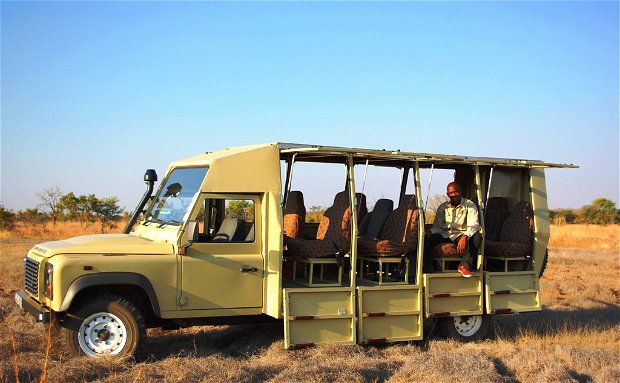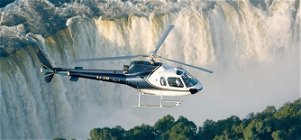About Safaris in Zambia

Transportation and Equipment:
We use Landrover Tdi with extended chassis to accommodate 10 bucket seats (8 window seats and 2 seats in the middle in the front row and back row respectively). The vehicle is specially adapted (double shocks and double coil springs etc.) to guarantee a comfortable drive on the bumpy tracks in the African wilderness. There is space for hand luggage (cameras etc.) in front of the first row of seats (above the driver and co-driver) and between the second and third row of seats. There is also space to stow luggage beneath the seats.
The side doors can be folded down to allow easy access into the vehicle. The vehicle is open on all sides, but can be closed completely with windows for long distance journeys.
The Landrover has a double battery system (car battery and replacement battery for the fridge) with a port (cigarette charging plug) for 12 Volt devices. In addition, an inverter is fitted to ensure charging for devices with 220 Volt (European plugs). The Landrover is equipped with a fixed roof (two of our Landrovers are fitted with detachable roofs).
The conditions of the roads vary every year depending on rainfall. The tracks are often only patched up after the rainy season, and occasionally we have to pave a short road section, or remove a tree that has been pushed across the road by an elephant. River crossing on the way, are rarely a serious obstacle as our Landrovers are well equipped to deal with these circumstances: elevated air intake for the engine (‘snorkel’) and modified ventilation for the gearbox and axles to prevent water entering into the drive train.
The trailer is fitted with a mobile kitchen. The luggage, tents and camping equipment is also packed in here. Two large (2 metres long) collapsible tables are carried with us on safari. Camping chairs (collapsible), grill, dishes, pots, tablecloths, coffee mugs, glasses (for wine and juice) etc. are part of the campsite inventory and are all packed away in the trailer. The lighting in the evening consists of camping lamps (connected to the car battery) and lanterns (candles) on the tables.
Our tents are large dome type tents (2,5 x 2.5 m and 2 metres high), and a maximum of 2 guests are accommodated in each. The tents are spacious and provide ample room for camping beds and luggage. The camping beds (ca. 2 metres long, 60 cm wide and 50 cm high) are fitted with 50 mm high density foam mattresses. Mattresses are covered with linen.
A small freezer is built into the Landrover to keep perishables (meat, cheese etc.) fresh. We also offer cold drinks to our guests. For this purpose, we use a cooler box filled with ice.
The crew consists of a local driver/guide and a trained cook who also acts as a general camp helper. The crew will do most of the work involved in a mobile safari, however clients on the camping safaris are requested to put up and fold their tents on their own. Our crew will gladly assist our clients (and of course will help single travellers). With the occasional assistance (e.g., packing the trailer etc.) of the participants things get done quicker.
On our lodge tours dinners are also prepared in our bush kitchen on open fire and gas stoves (except for Busanga Plains). Guests will eat their dinner under the open sky (normally on the campsite or a communal area provided by the lodges), lunch is normally served as a pic-nic lunch.
The meals are prepared from fresh and healthy ingredients. Canned foods are avoided where possible and only offered occasionally where fresh food is not available. Fresh meat and vegetables are an important part of the menu. Vegetarian cooking is offered, depending on the preference of participants. A full vegetarian menu can be organized with prior notice.Vegetables and fruit are purchased in the towns and villages, sometimes fresh from small, private vegetable gardens.
Fruit juice (mostly fresh fruit juice from South Africa, occasionally we offer fruit juice concentrate) and drinking water (groundwater or filtered water) is available throughout the journey. Alcoholic beverages are not included and can be purchased en route. (Approximate prices of alcoholic beverages: beer (330 ml): approx. € 1 00, wine: approx. € 8 00 per litre (depending on the quality)). We purchase canned beer and, preferably, wine in boxes. Bottles are always at risk on the bad roads.
Almost during the whole trip, we will have cell phone network, the use of European mobile phones is often possible near cities or populated areas.
Currency: Since June 2014 the US$ is accepted again as legal tender. The actual rate of exchange to the local currency (Zambian Kwacha, ZMW) 1 US$ = 25 ZMW (as at July 2024) Banks in Zambia don’t accept U$ dollar notes which were printed before 2017 - please ensure that you carry new notes without any marks and damages (the date is indicated on the bill).
Climate: October and November are very warm in the Luangwa and Zambezi valley: midday temperatures reach 35 to 38 Degrees Celsius. Considerable temperature fluctuations can occur during any season.
Visas: Visa fees have been waived since 1st November 2022 for several countries (all member states of the EU, Norway, USA, Canada, UK, New Zealand, Australia, China etc.). Most other nationalities have to pay visa fees of US 25 pp, the visa can be applied for at arrival (cash payment recommended).
COVID-19 regulation (as at March 2023):
Since 21st March 2023 all Covid-19 related travel restrictions have been lifted, so no proof of vaccination nor proof of negative disease status is necessary when entering the country.
A few things not to be forgotten:
Lightweight raincoat (it can rain in late October / November times).
A warm wind jacket (except October) and good long trousers (might get chilly after the rain).
Sunglasses
sunscreen lotion (cream).
The air is dry and in an open vehicle the skin can get dry. Hand cream (fatty cream) against dry hands
good camera (simple, small cameras are usually not suitable to make good photos, because the animals are often not so close). Digital cameras can be charged easily via cigarette lighter plug (12V) or with a normal European plug (220V).
Headlamp and/or good flashlight
Hat or cap
A pair of tennis shoes or even trekking shoes for any walks in the bush.
Soft bags are better to store in the trailer than suitcase with a hard shell.
Plastic bags to protect certain items from the dust
A bottle of water (at least 1 litre capacity)
Malaria prophylaxis is recommended
Other vaccinations are not mandatory, but recommended: i.e. vaccinations against hepatitis A and tetanus
We do have a first aid kit (especially bandages, medicines for diarrhoea and Antibiotic) on board. Please bring your own medication if needed (Antihistamines, cortisone, etc.)
Our journeys in Zambia lead us to remote and wild areas. Because of the conditions prevailing here we expect some degree of flexibility and patience from our guests. Reasonable health and physical fitness are a precondition for enjoying our tours.
Some roads are in bad condition with deep potholes, which makes driving difficult and takes a lot of time. Especially after the rainy season roads can be washed out, due to this fact it is sometimes unavoidable, that we arrive only after sunset at the lodge or campsite.
Zambia is an ideal combination of spectacular wildlife, beautiful African landscapes and a varied culture of the indigenous people.




.jpg?aspect_ratio=45%3A45&width=45)


Share This Page